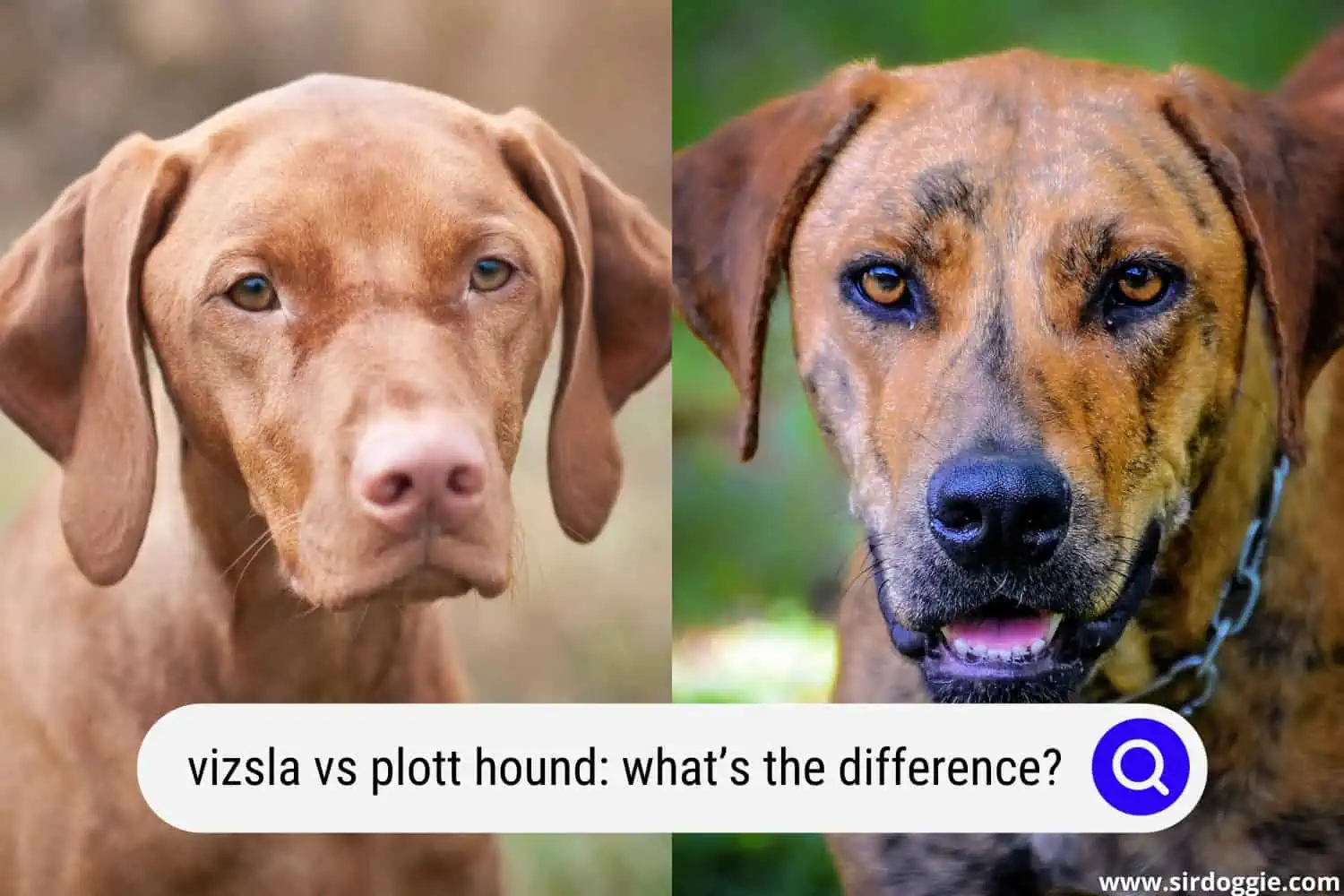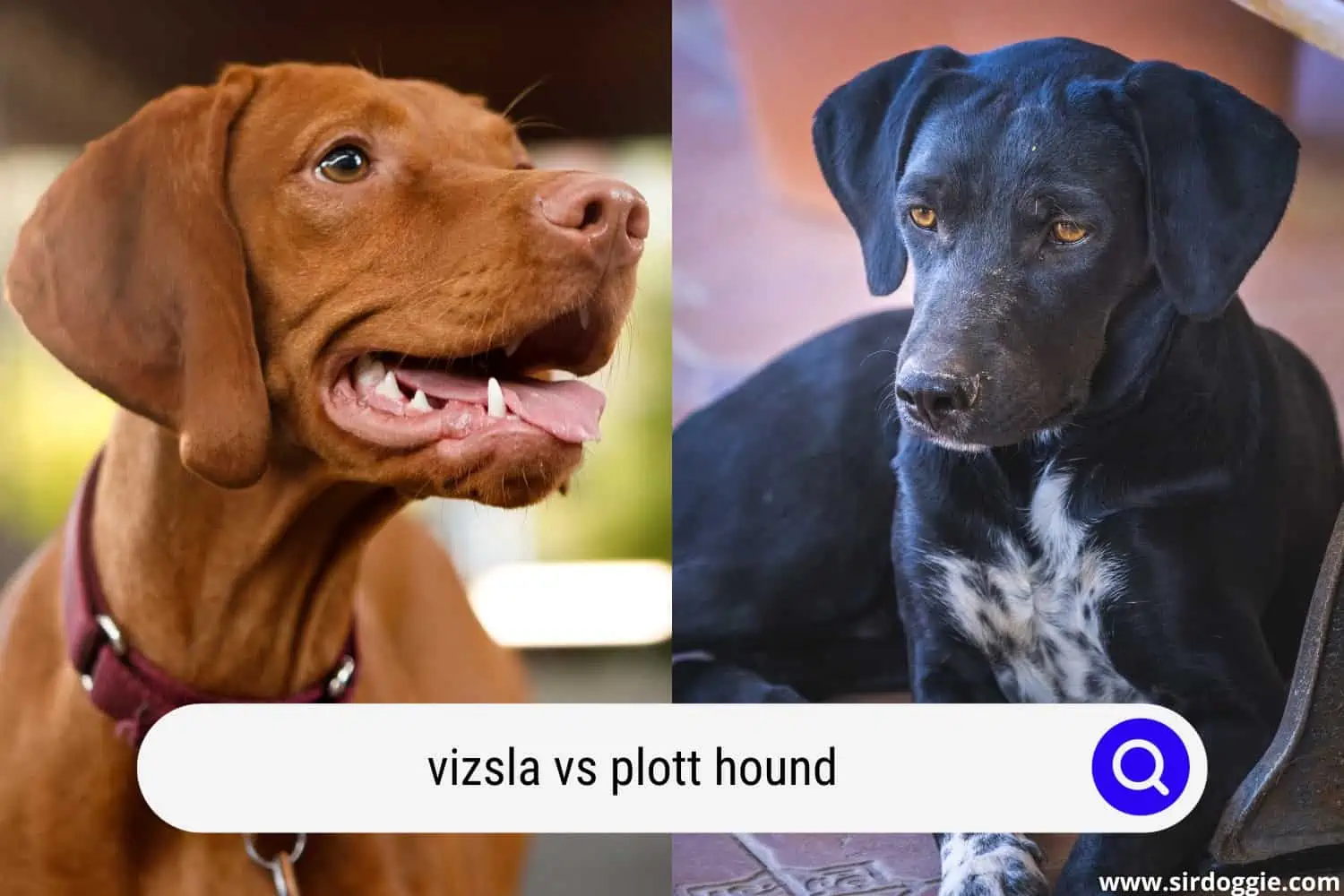Vizsla vs Plott Hound: What’s the Difference?
The Vizsla and the Plott Hound are two distinct dogs from different origins. These dog breeds are ideal for kids, have a low maintenance requirement, and are easy to groom.

However, while the Plott Hound isn’t for inexperienced owners, the Vizsla is ideal for new owners.
In this Vizsla vs. Plott Hound comparison, we will explain the differences and similarities between these two dogs and help you choose the best for you.
Related Reading: Vizsla vs Pharaoh Hound: What’s the Difference?
The Vizsla Dog
The Vizsla, also known as the Hungarian Shorthaired Pointer, is a very calm dog, easily learns from its training, as well as obeys its owners. The dog is very quiet to have at home. It is also very attached to the owners and likes to participate in their routine.
Vizsla Dog Temperament
Despite being a hunting dog and having a high-speed history, the Vizsla Bracoit is not one of the most agitated and troubled breeds as it might have been possible to imagine.
Leaving the dog alone in the forgotten yard can make him more agitated as it is a breed that likes company a lot and does not like to be alone for a long time.
Despite this and also due to the breed’s original characteristics, the Vizsla needs constant physical activity. It is very fond of playing and walking, and it is recommended to have an area for it to perform these activities and exercises.
Even if you have a yard, it is good to take it to more open environments whenever possible. For those who like competitions with dogs, Vizsla is also a great partner. As it is very strong and obedient, it is easy to train and to be able to demand some actions and attitudes that are typical of this type of competition.
Origin and History of the Vizsla
The Vizsla is a very old dog whose story is not easy to pin down on what happened over time. The most likely among historians is that it originated from the dog Sabueso da Pannonia.
From the first lineage after its ancestors, this new dog would have gone through another cross this time would be between Sloughi (a strong dog of North African origin) and another dog with hunter characteristics and that had colored hair that was used by Ottoman peoples in the 16th century. This is said to be a fact that influenced the final color of their coat.
If there is still any doubt about the dogs that came together to give rise to the Vizsla dog, the same cannot be said about the place of its birth: Hungary. And their first breeders have an even older history than those dogs.
More than a thousand years ago, a nomadic group called Magyars arrived in an area that now belongs to Hungary. This group was formed by valleys and hunters who had a dog that would originate the future Vizsla many years later.
Its official recognition, however, only came in the 19th century – a period also marked by another increase in the breed through crossings with another breed: the English Pointer.
This new intersection spawned a new Vizsla that was even faster. This breed is also known as the Hungarian Braco. It was at risk of extinction after the First World War, a fact that was only prevented by preservation actions.
It arrived in American territory in the 1960s in the United States.
Vizsla Unique features
The introduction of the English Pointer in its history made the breed a very fast, agile, and fast dog, which makes it an extremely athletic dog.
This agility and speed make it an excellent dog for hunting, especially in the pursuit and search for prey. The size is between medium and large. Generally the male measures between 58 and 64 centimeters with a variation of four centimeters for less in the case of the females (that is, varying between 54-60 cm).
Its posture is very reminiscent of Sloughi (possibly one of the dogs that originated him). It’s always attentive, with a beautiful and firm body expression. The coat is very short, smooth, and also soft.
It can present two variations in its color: rust and gold. Stains can be seen on the chest and legs, but are normal and should not be frightening. The eyes usually have a color similar to the color of their coat and should convey confidence to their owners.
The tail is long and can be cut up to 60% of its original size. But it is necessary to be aware of the rules of the country where they live since some of the countries in the world already prohibit this practice of cutting.
Vizsla Dog Care, health and life expectancy
If you have a negative health history with your dogs and are looking for a healthier option, Vizsla is a great idea. This breed is extremely healthy and rarely has any health problems.
Its life expectancy is up to 15 years and it reaches a certain frequency as long as the other health details are respected.
What can eventually appear and bother the dog is atrophy or dysplasia of the retina, worsening his vision. Even this problem should not arise early and only affects the breed more when it is old.
Vizsla Dog Feeding
The feeding of a Vizsla is not much different from other dogs of its size. The puppies should be fed three times a day but in smaller doses. The higher the quality of the feed, the less the quantity needed.
Remember that a good diet (Premium or Super Premium) can guarantee the important nutrients for healthy growth. As adults, they can only eat twice, but with food for this stage of life and, of course, more than the dose used for the puppy phase. The idea is to always consult a veterinarian before setting the amount and the ratio.
The Plott Hound
The Plott Hound is an American hunting dog, considered the official dog of the State of North Carolina. Despite its strong and robust appearance, it has a huge heart, being a faithful and loving companion. We will learn more about their origin, behavior, and care below.
Plott Hound Origin and History
Compared to the vast majority of hunting dog breeds, the origin of the Plott Hound is relatively recent. It appeared in 1750, when the German Johannes Georg Plott went to the United States, more precisely to North Carolina.
There, he took some hunting dogs with him. A hunter from the region then crossed these dogs with some females that he had.
The dogs that emerged with these crosses were being trained and improved for hunting wild boar, and thus the Plott Hound as it is known today originated.
However, the breed was only recognized much later, in 1946. Over time, due to its beauty and agility, this became the official dog of the State of North Carolina. Meanwhile, nowadays, the breed is not very popular, and most of the existing breeds are in their region of origin.
It is still used for hunting, but due to its friendly behavior, it also became a companion dog.
Plott Hound Temperament
Some medium and large dogs can be difficult to deal with, which makes it unfeasible for them to be used as companion dogs. This is not the case with the Plott Hound, because, in addition to being docile, it is also very intelligent and obedient. It gets along very well with people and other animals.
The Plott Hound is a very loving docile and gentle dog, which contrasts with his strong and fearless appearance. It is very attached to the owners and very fond of being with him. So it ended up conquering families and becoming a domestic dog.
It is great for families with children as it is playful, full of energy, and very patient. However, it is not recommended for children who are still very small and do not have much sense at the time of play. The dog, in a reflex, may end up hurting them because of its strength.
This breed is also extremely protective and is always alert. This makes it an excellent watchdog to keep at home, as it often starts to bark at any strength.
The Plott Hound is also extremely intelligent and great for training. It learns commands and tricks with enormous ease. Also, the breeds like to please, and this makes them very obedient and polite. However, it is necessary to train it from a puppy. This is the phase in which he learns much faster.
Plott Hound’s Unique features
This dog is considered medium to large. The male usually measures between 50 and 71 cm in height. The female is between 50 and 58 cm. The male’s weight generally varies between 23 to 27kg, while the female is a little lighter and usually weighs between 18 to 25kg.
Their hair is medium to thick, smooth, and double, which gives them extra protection since they were developed to live in the mountains of North Carolina, in the United States.
The dog of this breed can be found in several colors, such as black, brown, brindle, and yellowish, among others.
Plott Hound Care, health and life expectancy
This dog, which was bred for hunting, is usually quite healthy and very resistant. Their life expectancy can reach up to 14 years.
However, it is necessary to take some precautions so that its health is always up to date. The ears must always be clean. Also, when the dog gets wet, it must be dry. These precautions prevent possible infections and even hearing loss.
Another basic and important care is to take the Plott Hound to the vet regularly. Ideally, consultations should take place once or twice a year.

Comparison Table: Plott Hound vs. Vizsla
| Plott Hound | Vizsla | |
| General Details | ||
| Lifespan | Up to 14 yrs. | Up to 15 yrs. |
| Height | 20-25 inches | 21-25 inches |
| Weight | 40-75 pounds | 40-65 pounds |
| History | ||
| Origin Country | United States | Hungary |
| Temperament | ||
| Family Friendly | Very Good | Very Good |
| Kid-Friendly | Very Good | Very Good |
| Pet Friendly | Good | Very Good |
| Stranger Friendly | Below Average | Very Good |
| Living Environment | ||
| Apartment | No | No |
| Small Yard | No | No |
| Large Yard | Yes | Yes |
| Barks/Howls | Yes, Often | Yes, very Often |
| Exercise Needs | ||
| Exercise Required | Medium-High | High |
| Top Running Speed | 22mph | 24mph |
| Grooming Needs | ||
| Shedding | Low-Medium | Medium |
| Drool Amount | A bit high | Low |
| Health Comparison | ||
| Plott Hound | Vizsla | |
| Common Health Issues | ||
| Cancer | No | Yes |
| Epilepsy | No | Yes |
| Hip Dysplasia | No | Yes |
| Sebaceous Adenitis | No | Yes |
Conclusion
The Plott Hound is the best dog for you if you want a vibrant breed with little to no health risks. However, both dogs can live in apartments, small yards, and big yards. They are both families, kid, and stranger friendly. They are also not far apart in life expectancy.

Family Dog Expert Author
Hi there! I’m Stuart, a devoted dog lover and family dog expert with over a decade of experience working with our furry companions. My passion for dogs drives me to share my knowledge and expertise, helping families build strong, loving bonds with their four-legged friends. When I’m not writing for SirDoggie, you’ll find me hiking, playing with my beautiful dog, or studying music.